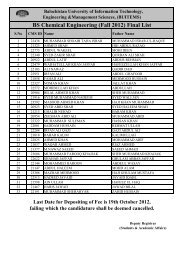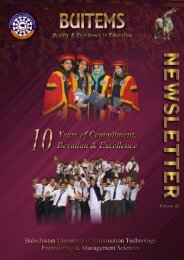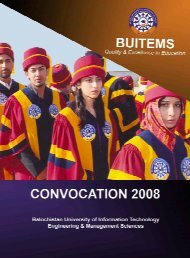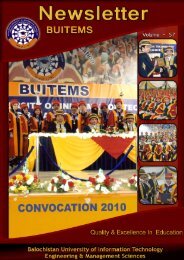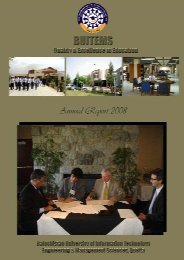BUITEMS
Research Journal - buitems
Research Journal - buitems
- No tags were found...
You also want an ePaper? Increase the reach of your titles
YUMPU automatically turns print PDFs into web optimized ePapers that Google loves.
<strong>BUITEMS</strong><br />
Quality & Excellence in Education<br />
Handshaking vs. Instant Broadcast in VANET Safety Message Routing<br />
0.1 message per second per vehicle where<br />
the hidden node problem may be acute,<br />
resulting in the handshake methods<br />
performing equally well. However,<br />
retransmission due to hidden node collisions<br />
in the higher message generation case do<br />
not significantly affect the IB performance as<br />
the delay (even in the higher rates) is close<br />
to the handshake based methods. Figure 4(b)<br />
depicts mean delay with respect to distance.<br />
We observe considerable delay gain of IB<br />
again over SB and UMB protocols with<br />
respect to distance. Note that the distance<br />
interval (300 meters) on x-axis roughly<br />
represents one hop communication range.<br />
Therefore, we observe that the delay gain of<br />
IB over the other two protocols doubles every<br />
hop, and it can be seen in the fourth hop that<br />
the delay gain of IB is about a significant 12<br />
milliseconds.<br />
Figure 4(c) depicts average load generated<br />
by each message in the network against<br />
vehicle density. The figure highlights an<br />
important achievement of IB protocol over the<br />
other two protocols. It provides the total<br />
number of bits transmitted in the network in<br />
order to disseminate a safety message to<br />
related nodes. In other words, it shows the<br />
channel reservation per safety event. The<br />
average load generated per message<br />
increases slightly with increasing vehicle<br />
density for all the three protocols due to<br />
retransmission triggered by collisions in the<br />
high density traffic. However, since IB<br />
involves only the actual message in the<br />
propagation mechanism, it generates the<br />
least amount of load in the network per<br />
message. Since the handshake based<br />
methods involve RTB and CTB overhead<br />
packets, and also, due to their resulting<br />
retransmission because of gagged station<br />
problems and masked station problems, their<br />
overall load generated per message is<br />
higher. The evaluation results show that<br />
Instant Broadcast offers equal reliability as<br />
the methods using handshaking mechanism,<br />
and at the same time improves the overall<br />
safety message propagation delay by<br />
avoiding overhead messages.<br />
CONCLUSION<br />
In this paper, we have analyzed the use of<br />
handshaking mechanism for safety message<br />
dissemination in VANETs. Instant Broadcast<br />
routing without using handshaking is<br />
asserted to be used for multi-hop safety<br />
message dissemination in VANETs. Our<br />
extensive simulation results using ns-3<br />
simulator suggest that Instant Broadcast<br />
significantly improves the message<br />
propagation delay and ensures reliability of<br />
reception by all the nodes in the multi-hop<br />
range. The evaluation of handshaking<br />
mechanism presented in this paper will assist<br />
future researchers in considering<br />
handshaking while designing VANET<br />
communication protocols. Theoretical delay<br />
analysis for instant broadcast method is also<br />
developed in this paper, which can be<br />
extended for delay calculation of any<br />
broadcast method in VANETs. Future work<br />
can be directed towards further investigation<br />
of the contention resolution mechanism and<br />
exploit some novel parameters such as<br />
vehicle type and lane number with respect to<br />
message originator. In this paper, we have<br />
presented a new technique for sectoring the<br />
broadcast range for safety message routing<br />
in VANETs. Rush hour traffic scenario is<br />
considered where most of the hitherto<br />
mechanisms are severely affected with<br />
collisions and consequent high message<br />
propagation delays. The hitherto neglected<br />
factor of road width is introduced to be used<br />
as a second dimension for sectoring the<br />
transmission range of the message sender.<br />
Collision gain of the proposed technique is<br />
evaluated using Marchov chains. Extensive<br />
simulation evaluation is performed using ns-3<br />
simulator, and the results suggest that Lane<br />
based sectoring significantly improves the<br />
message propagation delay by as much as<br />
9 ms for rebroadcast in each hop while at the<br />
same time improves reliability of message<br />
propagation by reducing rebroadcast<br />
collisions by 2% over the existing sectoring<br />
technique even in worst traffic scenario.<br />
Uncovering the importance of road width for<br />
VANETs in this paper will assist future<br />
researchers in understanding a more detailed<br />
road topology that influences VANET<br />
45



